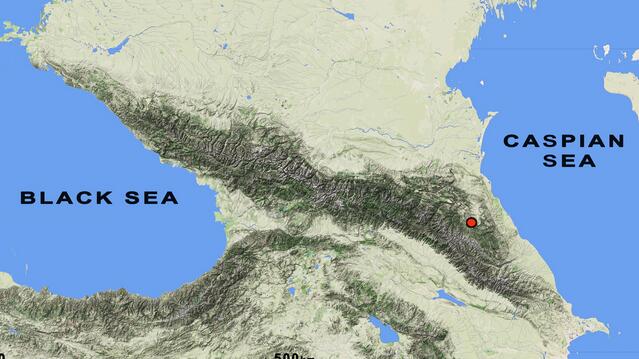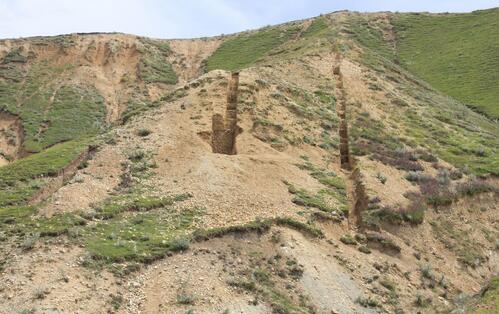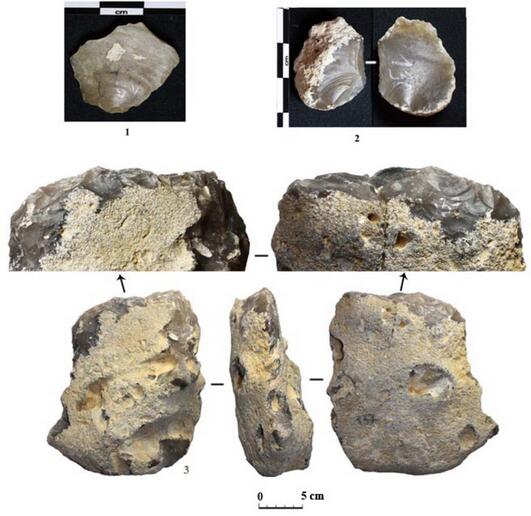Early Humans at the eastern gate of Europe: The discovery and investigation of Oldowan sites in northern Caucasus
From:Shanghai Archaeology Forum NetWriter:Date:2017-12-15
In 2003 target searches for early Pleistocene sites in the Northeast Caucasus was started for the first time. The greatest effect in these works was achieved in the mountain region of internal Dagestan. Prior to these studies there was no information on any Palaeolithic sites here with archaeological finds in the geological context. Currently, after more than ten years of research in the eastern part of the North Caucasus (Central Dagestan; Akusha District of the Republic of Dagestan), the Ainikab-Muhkai-Gegalashur group consisting of eight multilayer Early Pleistocene sites is being studied. The total number of the revealed cultural layers of the objects comes close to a hundred.The Muhkai sites, which are being excavated at the present time, demonstrate the thickness of section that is unprecedented for the archaeological sites of the Early Pleistocene. At the site of Muhkai 2 the thickness of the section, for instance, is 73 meters. These geological member contain 34 Early Paleolithic cultural layers, distributed from the bottom upwards throughout the whole section. The total of all cultural layers of the site covers the chronological range from not later than 1.95 Ma to 0.8 Ma.

Geochronology of the Oldowan sites of Central Dagestan is based on the data of multidisciplinary researches involving possibilities of ESR dating method, geology, geomorphology, paleopedology, paleomagnetic studies, biostratigraphy, palynology, and phytology.
The presence of diverse materials of multidisciplinary research makes the dating of the sites evidential. Synthesis of the results of various laboratory tests makes it possible to obtain a complete and in many respects detailed picture of the development of the culture and natural environment in the region of the North-East Caucasus throughout the Early Pleistocene.
The fact that some cultural layers were excavated over a large area and provided with numerous collections of stone tools enables in some cases to conduct a detailed typological analysis. The results of the latter, in its turn, serve as a ground for well-reasoned conclusions of technical and typological aspects of stone tools of the studied sites, their common features and specific manifestations.
Specific cultural layers have been excavated over a relatively wide area. For example, layer 80 of the site of Muhkai 2 has been investigated over the area of 44 square meters. The area of layers 2013-1 and 2013-2 of the site of Muhkai 2a is nearly the same. The area of opening of the lower layers at the site of Ainikab 1 exceeds 30 square meters.
The sites of different geomorphological zones of the territory under consideration have various geological characteristics and essentially differ from each other in terms of informativeness and opportunities for cultural and historical reconstructions. The occurrence of the sites in situ with undestroyed “habitation surfaces” makes it possible to establish a functional type of the Oldowan sites of Central Dagestan. Butchery and kill sites (and/or “meat gathering”? places) are distinguished on reasonable grounds and this fact points at the possible existence of objects for other purposes, for example, base camp sites, among the Oldowan sites of this region.
In terms of general typological and technological characteristics the industry of Dagestan sites reveals fundamental similarity with the data of the classic Oldowan of the Olduvai Gorge in East Africa. During the interval from ca. 2 to 0.8 Ma the major categories of tools of the Oldowan sites of Central Dagestan were the chopper and the pick. The biface, in any of its typological terms, was not revealed in the industry under investigation. Elements of bifacial processing and emergence of rare pieces gravitating towards bifaces (protobifaces, partial bifaces) were registered in the upper layers of the total thickness of the deposits, corresponding to the time interval from the end of the Jaramillo paleomagnetic episode to the Brunhes-Matuyama boundary, i.e. ca. 0,99 Ma – 0.8 Ma.

In this way the studied industry does not have the features required to distinguish it as a specific regional variety of the Early Pleistocene culture. But the stone tools of the Oldowan sites of Dagestan demonstrate some peculiarities. For example, relative multiplicity of the pick category or the presence of the expressive tools – gigantolites. However, these factors do not change the “typological image” of the industry.
In the sections of relatively well studied Muhkai sites the evolution of the industry is registered from the lower to upper layers. Its visible manifestations may be defined as follows:
1.at the top of the sections the manufacturing of massive tools was not limited to knapping along the contour of the primary blank and using only “chopping” and sharpening types of treatment. The use of the technique of flat working began but it had not led to the emergence of new types of tools (e.g., bifaces) yet, though contributed to the rise of protobifaces;
2.the use of large massive flake in the function of a blank is registered at the top of the deposits of the Muhkai sites. It is noteworthy, however, that only those types of tools, which are typical of the Oldowan industry – the chopper and the pick – were manufactured from these blanks;
3.the evolution in expanding the range of small tools on flakes and their quantitative representation is not observed within the period of formation of the deposits of the Ainikab-Muhkai sites.

On the basis of specific sources the problem of the ways and time of the initial human occupation of West Eurasia is considered, and the role and place of the North Caucasus and Ciscaucasia in this process is determined. According to the materials from Central Dagestan the initial colonization of the North Caucasus occurred during the Biber-Danube interglacial stage (ca. 2.3 – 2.1 Ma) or, at least, not later than this time. One of the ways of the original colonization of Eurasia ran along the western coast of the Caspian Sea. On a large part of the East European Plain the outset of the progressive development of the culture and the historical process in whole was connected with the penetration here of the first human groups through the “Caspian corridor”. The West-Caspian way of the initial occupation was at once a transit route for moving towards Eastern Europe and North-West Asia, and a natural refuge, which in the case of need provided people with necessary resources during a very long period of time. The North-East Caucasus and, in particular, Inner Dagestan, became a sort of cultural reservoir of the Oldowan epoch, where the ancient culture found the necessary conditions for a very long existence in its traditional form.
The environmental conditions in the North-East Caucasus were characterized by rhythmic alternation from wet and relatively warm to warm and relatively dry climate. In the sections of the specified sites the former chronologically coincide with the stages of the Pliocene-Early Pleistocene glaciations, and the latter – with the interstadials. Accordingly, during the interstadial intervals, corresponding to transgressions of the Caspian Sea, the landscapes close to marsh most probably began to spread over the territory of today’s Central Dagestan.
Conditions with the characteristics typical of savanna were peculiar to the other periods of the Early Pleistocene. The studies discussed above were carried out at the Institute of Archaeology of the RAS and the Institute of History, Archeology and Ethnography of the Dagestan Scientific Center of the RAS (Russian Academy of Sciences). Laboratory investigations and identifications of the natural science materials were conducted at the Institute of Geography of the RAS, Geological Institute of the RAS, Lomonosov Moscow State University, Paleontological Institute of the RAS, and Zoological Institute of the RAS. A part of tyhe included materials was obtained owing to funding by the Russian Foundation for Basic Research.

